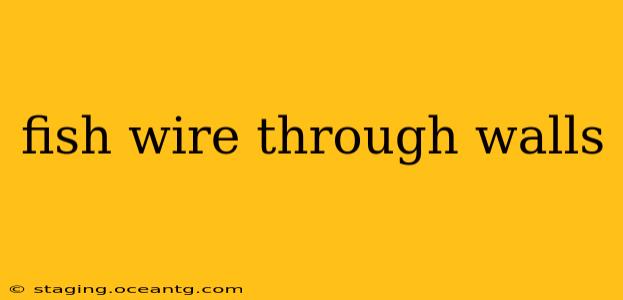Have you ever needed to run a wire through a wall but couldn't find an easy way to do it? This comprehensive guide will cover various techniques for successfully fishing wire through walls, addressing common challenges and offering solutions for different situations. Whether you're installing network cables, electrical wiring (though caution is advised – always consult a professional electrician for electrical work), or even stringing Christmas lights, we'll explore the best methods to get the job done efficiently and safely.
What's the Easiest Way to Fish Wire Through a Wall?
The easiest way often depends on the wall's construction and the access points available. For simple situations, a flexible wire snake or a fish tape is usually sufficient. These tools allow you to feed a wire through existing openings, like electrical boxes or gaps between wall studs. However, if you lack accessible openings, more advanced techniques might be needed.
How Do You Fish Wire Through a Wall Without Access?
Fishing wire through a wall without access is trickier and may require more creative solutions. Here are a few options:
-
Drilling Pilot Holes: Carefully drilling small pilot holes at strategic points can create access points. Remember to always check for existing wiring or plumbing before drilling! Use a stud finder to avoid damaging structural elements.
-
Using a Flexible Endoscope or Inspection Camera: This allows you to visually inspect the wall cavity and identify potential pathways for your wire. This is particularly useful for avoiding obstacles.
-
Creating a Small Access Hole: In some cases, carefully cutting a small access hole (and patching it later) might be the most efficient solution. Again, be cautious and ensure you’re not damaging anything important.
-
Utilizing Existing Services: If the wall is shared with an adjacent room, you might be able to fish the wire from the adjacent space.
Can You Use a Vacuum to Pull Wire Through Walls?
While not a common method, in certain scenarios, a vacuum cleaner can assist in pulling a thin wire through a wall. Attach a lightweight cord to the end of the wire, and carefully place the cord's free end into the vacuum hose. The vacuum’s suction can help pull the wire through. However, this method is most effective with relatively short distances and few obstructions.
How to Fish Wire Through Drywall?
Drywall, being a relatively soft material, is generally easier to work with. Using a wire snake or fish tape, carefully feed the wire through existing openings or create small access holes as mentioned earlier. Remember to be gentle to avoid tearing the drywall. Patching small holes is typically straightforward with drywall compound and paint.
How to Fish Wire Through Brick Walls?
Brick walls present a greater challenge. Drilling is more demanding, and you need to be extremely careful to avoid damaging bricks or existing wiring/plumbing. A professional approach might be preferable, or carefully planned drilling with appropriate safety measures. Using a long and sturdy fish tape is crucial here.
What's the Best Tool for Fishing Wire Through Walls?
The "best" tool depends on the specific situation. However, these are commonly used and effective:
- Fish Tape: A flexible metal tape that can navigate bends and obstacles.
- Wire Snake: A flexible plastic or metal snake with a stiff wire at the end to navigate obstacles.
- Magnetic Fish Tape: A fish tape with a strong magnet on the end for retrieving small, metal objects.
Remember, safety should always be your top priority when working with walls and wiring. If you're uncomfortable with any of these techniques, it's best to consult a qualified professional. Improper wiring can lead to serious risks, including electrical hazards and potential fire damage.
